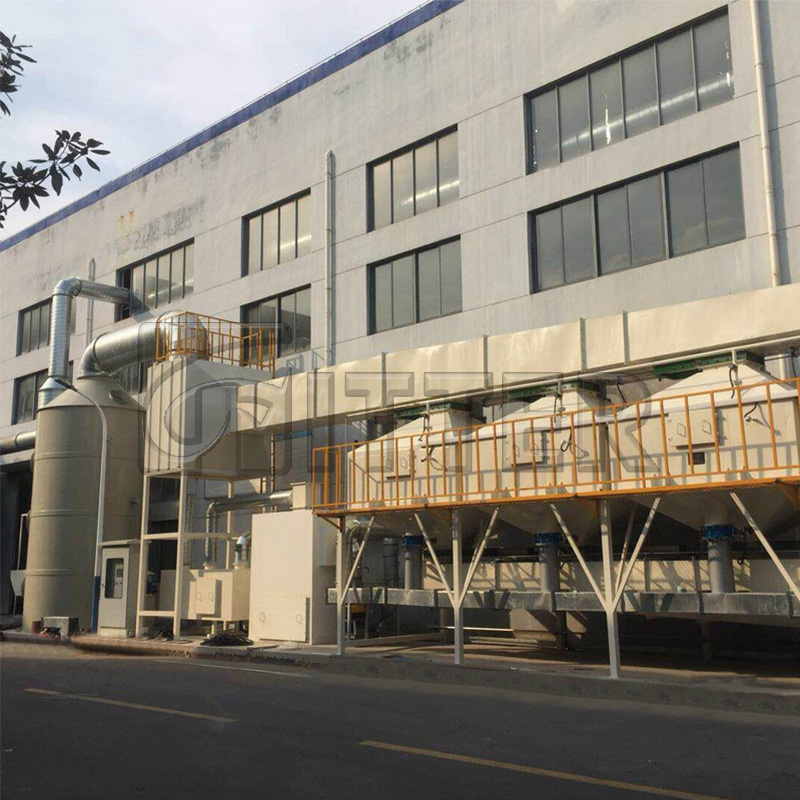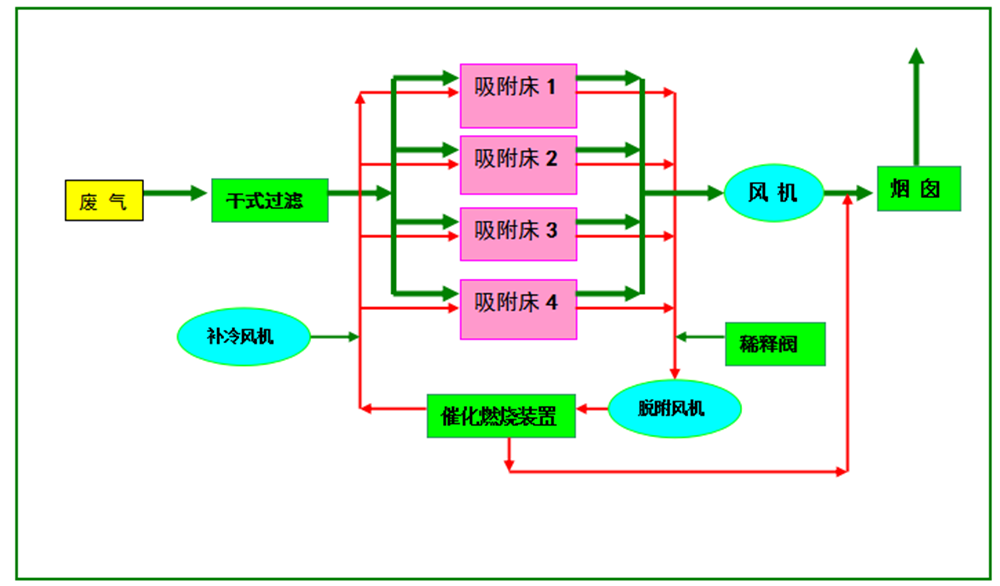Products
-
Current position:Home - Products
RCO catalytic combustion system
Product description

1.working principle
The working process of the device can be divided into two phases, the activated carbon adsorption phase and the activated carbon desorption regeneration phase. The working principles of the two phases are as follows:
① Adsorption process:
The exhaust gas discharged from the workshop is removed by the paint mist coarse filter and then enters the activated carbon adsorption device. When the organic exhaust gas passes through the activated carbon layer, the organic components in the exhaust gas are attracted to the surface of the activated carbon and concentrated on it. The organic component is thus separated from the other components, and the other component gas (clean gas) is evacuated by the fan.
② Regeneration process:
Activated carbon is used for a period of time. After a certain amount of solvent is adsorbed, the adsorption capacity will be reduced or lost. At this time, the activated carbon needs to be desorbed and regenerated. After regeneration, the activated carbon resumes the adsorption function, and the activated carbon can continue to be used. During regeneration, the power of the preheating chamber of the catalytic combustion device is started, and the air is preheated. The preheated gas is sent to the adsorption box. After the activated carbon in the box is heated, the solvent adsorbed by the activated carbon evaporates. Combustion and decomposition generate hot air such as CO2 and H2O steam. Part of the hot air returns to the activated carbon adsorption box to continue heating the activated carbon, and part of it is evacuated. The activated carbon can be regenerated by circulating the activated carbon multiple times.
When the concentration of the organic waste gas reaches more than 2000 ppm, the catalyst bed can be maintained naturally without the desorption regeneration of external heating. This can meet the thermal energy required for combustion and desorption and greatly save energy consumption.
The equipment runs in a fully automatic cycle. When an adsorber is saturated and needs to be desorbed and regenerated, the PLC program automatically switches to the adsorber to perform the desorption work. After the adsorber enters the desorption work, the device can automatically turn on and off accordingly. The components also provide various over-temperature protection to ensure that the desorption work runs stably and safely; after the desorption work is completed, the adsorption box can automatically enter the adsorption state or standby state.
2.Process flow
This device adopts the process of lacquer mist filtration + activated carbon adsorption concentration + catalytic combustion desorption regeneration. The process of organic waste gas treatment is as follows (take 4 adsorption chamber process as an example)
The working process of the device can be divided into two phases, the activated carbon adsorption phase and the activated carbon desorption regeneration phase. The working principles of the two phases are as follows:
① Adsorption process:
The exhaust gas discharged from the workshop is removed by the paint mist coarse filter and then enters the activated carbon adsorption device. When the organic exhaust gas passes through the activated carbon layer, the organic components in the exhaust gas are attracted to the surface of the activated carbon and concentrated on it. The organic component is thus separated from the other components, and the other component gas (clean gas) is evacuated by the fan.
② Regeneration process:
Activated carbon is used for a period of time. After a certain amount of solvent is adsorbed, the adsorption capacity will be reduced or lost. At this time, the activated carbon needs to be desorbed and regenerated. After regeneration, the activated carbon resumes the adsorption function, and the activated carbon can continue to be used. During regeneration, the power of the preheating chamber of the catalytic combustion device is started, and the air is preheated. The preheated gas is sent to the adsorption box. After the activated carbon in the box is heated, the solvent adsorbed by the activated carbon evaporates. Combustion and decomposition generate hot air such as CO2 and H2O steam. Part of the hot air returns to the activated carbon adsorption box to continue heating the activated carbon, and part of it is evacuated. The activated carbon can be regenerated by circulating the activated carbon multiple times.
When the concentration of the organic waste gas reaches more than 2000 ppm, the catalyst bed can be maintained naturally without the desorption regeneration of external heating. This can meet the thermal energy required for combustion and desorption and greatly save energy consumption.
The equipment runs in a fully automatic cycle. When an adsorber is saturated and needs to be desorbed and regenerated, the PLC program automatically switches to the adsorber to perform the desorption work. After the adsorber enters the desorption work, the device can automatically turn on and off accordingly. The components also provide various over-temperature protection to ensure that the desorption work runs stably and safely; after the desorption work is completed, the adsorption box can automatically enter the adsorption state or standby state.
2.Process flow
This device adopts the process of lacquer mist filtration + activated carbon adsorption concentration + catalytic combustion desorption regeneration. The process of organic waste gas treatment is as follows (take 4 adsorption chamber process as an example)

Equipment system composition
The equipment system consists of five major systems: dry filtration system, activated carbon adsorption system, catalytic combustion regeneration system, electrical control system and ventilation duct system.
① Dry filter system: including filter box, filter material, etc.
② Activated carbon adsorption system: including adsorption box body, activated carbon, instrument valve, fan motor, etc.
③ Catalytic combustion regeneration system: including electric heating preheating chamber, catalytic combustion chamber, heat exchanger, connecting pipes, instrument valves, electric heating tubes, catalyst, fan motor, etc.
④ Electrical control system: including PLC electrical control cabinet, touch screen, meters, electrical pipelines, etc.
⑤ Ventilation duct system: Including all connecting pipes, valves and soot.
The equipment system consists of five major systems: dry filtration system, activated carbon adsorption system, catalytic combustion regeneration system, electrical control system and ventilation duct system.
① Dry filter system: including filter box, filter material, etc.
② Activated carbon adsorption system: including adsorption box body, activated carbon, instrument valve, fan motor, etc.
③ Catalytic combustion regeneration system: including electric heating preheating chamber, catalytic combustion chamber, heat exchanger, connecting pipes, instrument valves, electric heating tubes, catalyst, fan motor, etc.
④ Electrical control system: including PLC electrical control cabinet, touch screen, meters, electrical pipelines, etc.
⑤ Ventilation duct system: Including all connecting pipes, valves and soot.
-
- Fitter Environmental
- Professional air pollution prevention manufacturer

-
- ABOUT US
- Company
- Development
- Culture
- Advantage
- Honor
-
- VIDEO
- Video
-
- RECRUITMENT
- Recruitment
- Development
- Culture
- Advantage
- Honor
-
- CONTACT
- Contact us
- Message
Copyright @ 2019 Copyright Kunshan Feitter Environmental Technology Co., Ltd. Su ICP:15006502-1 Technical Support:昆山网站设计
 Welcome to the official website of Kunshan Feitter Environmental Technology Co., Ltd.
Welcome to the official website of Kunshan Feitter Environmental Technology Co., Ltd. Hotline:0512-36904088
Hotline:0512-36904088







